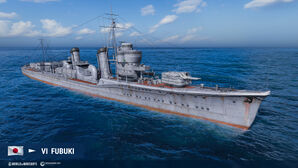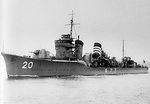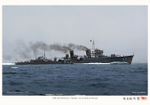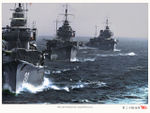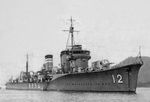Fubuki
| Revision as of 03:41, 30 November 2016 | Revision as of 04:02, 30 November 2016 Added photos to Historical Gallery. | |||
| Line 93: | Line 93: | |||
| ====Design==== | ====Design==== | |||
| ? | After the end of World War I, the Imperial Japanese Navy General Staff issued requirements for a destroyer with a maximum speed of 39 knots, range of 4000 nautical miles at 14 knots, and armed with large numbers of the recently developed Type 8 torpedoes. These destroyers were intended to operate with the new series of fast and powerful new cruisers also under consideration as part of a program intended to give the Imperial Japanese Navy a qualitative edge with the world's most modern ships.< | + | After the end of World War I, the Imperial Japanese Navy General Staff issued requirements for a destroyer with a maximum speed of 39 knots, range of 4000 nautical miles at 14 knots, and armed with large numbers of the recently developed Type 8 torpedoes. These destroyers were intended to operate with the new series of fast and powerful new cruisers also under consideration as part of a program intended to give the Imperial Japanese Navy a qualitative edge with the world's most modern ships.< | |
| ? | The resultant Fubuki class (吹雪) was ordered under the 1923 fiscal year budget, with ships completed between 1926 and 1931. Their performance was a great improvement over previous destroyer designs, so much so that they were designated Special Type destroyers. The large size, powerful engines, high speed, large radius of action, and unprecedented armament gave these destroyers the firepower similar to many light cruisers in other navies. | + | The resultant ''Fubuki'' class (吹雪) was ordered under the 1923 fiscal year budget, with ships completed between 1926 and 1931. Their performance was a great improvement over previous destroyer designs, so much so that they were designated Special Type destroyers. The large size, powerful engines, high speed, large radius of action, and unprecedented armament gave these destroyers the firepower similar to many light cruisers in other navies. | |
| ? | The Fubuki-class vessels were originally intended to only have hull numbers due to the projected large number of warships the Japanese Navy expected to build through the Eight-eight fleet plan. This proved to be extremely unpopular with the crews and was a constant source of confusion in communications with the earlier Kamikaze and Mutsuki-classes, and naval policy was changed in August 1928. Hence, the Fubuki-class vessels were assigned names as they were launched. | + | The ''Fubuki''-class vessels were originally intended to only have hull numbers due to the projected large number of warships the Japanese Navy expected to build through the Eight-eight fleet plan. This proved to be extremely unpopular with the crews and was a constant source of confusion in communications with the earlier ''[[Kamikaze]]'' and ''[[Mutsuki]]''-classes, and naval policy was changed in August 1928. Hence, the ''Fubuki''-class vessels were assigned names as they were launched. | |
| ? | The closest equivalents in the United States Navy were the Porter- and Somers-class destroyers, of which only thirteen vessels were constructed in the 1930s to function as destroyer squadron leaders. | + | The closest equivalents in the United States Navy were the ''Porter''- and ''Somers''-class destroyers, of which only thirteen vessels were constructed in the 1930s to function as destroyer squadron leaders. | |
| |HistoricalGallery=<!-- write below list of files without tags. description (if necessary) for each should be separated with | --><gallery> | |HistoricalGallery=<!-- write below list of files without tags. description (if necessary) for each should be separated with | --><gallery> | |||
| File:Fubuki Class Destroyer.jpeg|''Fubuki'' shortly after her commissioning in 1927. | File:Fubuki Class Destroyer.jpeg|''Fubuki'' shortly after her commissioning in 1927. | |||
| + | File:08d63afa.jpg|''Fubuki'' undergoing sea trials in Miyazu Bay, Honshu, 1928. | |||
| + | File:46c3efad.jpg|''Fubuki''-class destroyers cruising in formation, 1941. | |||
| + | File:Murakumo2.jpg|''Murakumo'' at anchor, date unknown. | |||
| File:Fubuki-class.jpeg|US Office of Naval Intelligence drawing of ''Fubuki''. | File:Fubuki-class.jpeg|US Office of Naval Intelligence drawing of ''Fubuki''. | |||
| ? | ||||
| </gallery> | </gallery> | |||
Revision as of 04:02, 30 November 2016
| 127 mm/50 3rd Year Type on a Type C mount2 х 2 pcs. |
| Rate of Fire8 shots/min. |
| Reload Time7.5 sec. |
| Rotation Speed6.9 deg./sec. |
| 180 Degree Turn Time26.09 sec. |
| Firing Range10.47 km. |
| Maximum Dispersion93 m. |
| HE Shell127 mm HE Type1 |
| Maximum HE Shell Damage2,150 |
| Chance of Fire on Target Caused by HE Shell9 % |
| Initial HE Shell Velocity915 m./s. |
| HE Shell Weight23 kg. |
| AP Shell127 mm AP Type0 |
| Maximum AP Shell Damage2,200 |
| Initial AP Shell Velocity915 m./s. |
| AP Shell Weight23 kg. |
| 610 mm Triple3 х 3 pcs. |
| Rate of Fire0.82 shots/min. |
| Reload Time73 sec. |
| Rotation Speed25 deg./sec. |
| 180 Degree Turn Time7.2 sec. |
| TorpedoType8 |
| Maximum Damage14,600 |
| Torpedo Speed63 knot |
| Torpedo Range6 km. |
| 13 mm/76 Type 93 on a twin mount2 х 2 pcs. |
| . . . Average Damage per Second4 |
| . . . Firing Range1.2 km. |
| 25 mm/60 Type 96 on a twin mount5 х 2 pcs. |
| . . . Average Damage per Second13.5 |
| . . . Firing Range2.49 km. |
| 13 mm/76 Type 93 on a single mount4 х 1 pcs. |
| . . . Average Damage per Second5.6 |
| . . . Firing Range1.2 km. |
| Maximum Speed35 knot |
| Turning Circle Radius640 m. |
| Rudder Shift Time3.8 sec. |
| Surface Detectability Range6.71 km. |
| Air Detectability Range2.99 km. |
Fubuki — Japanese Tier VI destroyer.
The Washington Naval Treaty restricted the tonnage of battleships and aircraft carriers, leaving ships lighter than 10,000 tons aside—this encouraged the development of a "new class" destroyer design. She was to have a displacement of 1,900 tons, 127 mm guns, and a triple-tube torpedo launcher. The project was approved in 1926, resulting in 20 ships being built under it. Fubuki entered service in August 1928. During World War II, she provided protection for the Japanese landings in French Indochina, Malaya, and the Dutch East Indies, and she engaged in the Battles of the Sunda Strait and Midway.
Modules
Compatible Upgrades
| Slot 1 |
|||||
|---|---|---|---|---|---|
| Slot 2 |
|||||
| Slot 3 |
|||||
| Slot 4 |
Player Opinion
Performance
The chronological predecessor of the Hatsuharu, the Fubuki-class nevertheless remains an upgrade over its compact and downsized successor. With three sets of double high-velocity 12.7cm guns (Two in superfiring position in the rear), the Fubuki-class' accuracy and range make gunfights with its American equivalents a viable, if exceedingly dangerous option. While its visibility is a downgrade from the Hatsuharu, the Fubuki can mount the concealment improvement modifications made available from tier 8 on, significantly reducing its visibility to 6.3km. Combined with three triple torpedo launchers which upgrade to launch 15km torpedoes, the Fubuki presents the most dramatic improvement to IJN DD capabilities since the Minekaze.
Fubuki's strengths and weaknesses remain largely the same as its predecessors, albeit reduced - it remains at a significant disadvantage against US DDs in a close-range gunfight, though its accuracy and low shell travel time allow it to hold its own at range. Its turrets, like the Hatsuharu's (and unlike the single turrets of USN DDs and lower-tier IJN DDs), are ponderously slow in turning and prone to being knocked out and are frighteningly fragile under fire thanks to the weak armor common to all DDs. In keeping with the trend since the Minekaze, the Fubuki is also slightly slower. Fubuki inherits Hatsuharu's improved torpedoes, but can upgrade for a 50% increase in range in exchange for slightly decreased speed. As in-game detection is dependent on torpedo speed, this handicaps the Fubuki less than one might think. Combined with a third launcher, the Fubuki can launch thick carpets of torpedoes its predecessors and American equivalents can't match or retain the third set for emergencies. Do not, however, take the increased range to mean that the Type 90s are most effective at 15km. Combined with its slower speed and greater travel distance, even tight spreads launched from 15km can become spread out to the point of being easily avoidable. The Fubuki's torpedos are still best launched at the very edge of detection range - like the Minekaze's 10km torpedos, the extra range only allows a bit of flex room for the well-protected BB or unexpected circumstance. Combined with the lessons learned from the Mutsuki and Hatsuharu, the Fubuki represents the high point for the post-Minekaze IJN DD playstyle, combining usable guns with potent torpedo armament.Pros:
- Accurate, high-velocity and long-ranged guns, can stealth-fire.
- Detection range improves significantly over Hatsuharu with appropriate mods
- Flexible 3x3 torpedo setup
- 15km torpedo range allows greater versatility and opens the possibility of long-range launches
Cons:
- Stock detection range represents a downgrade from the Hatsuharu
- C hull is basically a downgrade because you lose a gun and AA barely improves.
- Continued deterioration in top speed
- Inferior ROF and gun traverse compared to USN.
- Fragile turrets combined with low armor overall.
Optimal Configuration
Commander Skills
Fubuki has sufficient firepower to be a threat to capital ships, in addition to her stealth firing capabilities if built correctly. The following build shows the best build for a hybrid gunboat.
| Recommended Commander Skills | ||||||||
|---|---|---|---|---|---|---|---|---|
| Cost (points) |
Endurance | Attack | Support | Versatility | ||||
| 1 |
|
★★ |
★ |
|
|
|
★ |
|
| 2 |
★ |
★★ |
★★★ |
★★ |
|
|
|
★★★ |
| 3 |
★ |
★★ |
★★ |
|
★★★ |
★★★ |
★★★ |
★★ |
| 4 |
|
★ |
|
|
★★★ |
|
|
★★★ |
| Key: ★★★ - Extremely Useful ★★ - Frequently Useful ★ - Occasionally Useful No stars - Meh Χ - Not recommended | ||||||||
Gallery
Fubuki fires her main guns at an enemy North Carolina.
Historical Info
Historical Gallery
